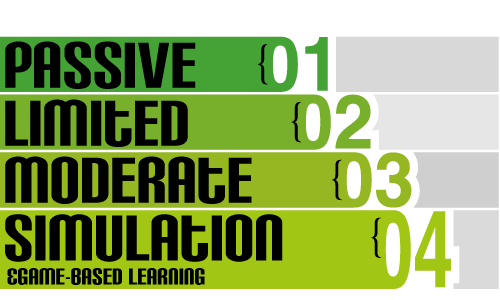If you are using eLearning resources, planning to develop or just interested in this type of training, you should know that eLearning courses can be classified according to the level of interactivity offered.
According to these levels of interactivity you can determine how interactive you want your eLearning courses to be. Therefore, if you are just looking to distribute basic information, a simple page-turner course could meet your requirements. However, if you are looking for an actual engagement and interaction by the learner, a more interactive eLearning course is a must-have. Using the right amount of interactivity is key. Not necessarily the more interactive the course, the more effective it will be. Use the right type of interaction according to your needs and objectives.
Which levels of interactivity do you need?
The interaction level that fits the most for your company and your corporate objectives is based on many factors, for example:
- The nature of the content
- Your technological infrastructure
- Budget
- Target audience
Level of Interaction: is a metric used in eLearning that refers to concepts such as user interaction, complexity and level of sophistication of the course.
Let's look at the details:

Level 1. Passive-no interaction
This level is what is commonly referred to as ‘page-turners'. The course is linear and could be considered basic training, in which the student acts only as an information receiver.
Basically, the sequence of screens is fixed and the student can not choose the order in which you want to see the content, return to a previous topic or browse freely. It is a level that isn’t very motivating to the learner. This is barely considered eLearning, however it can be effective for communicating simple concepts, and is relatively inexpensive to develop.
At this level learners do not interact with resources, they just have:
- Graphics, images and simple animations
- Rollovers
- Basic quiz questions
Level 2. Limited interaction
In this case, the course continues to be basic, but the student has more control over their training; they have the ability to do more than just watch, read and navigate. This level is used for non-complex operations and maintenance lessons.
At this level learners interact with resources such as:
- Clickable animated graphics
- Navigation expands to menus, glossaries, and links to external resources.
- Often includes simple exercises (i.e. drag-and-drop, matching, and identification components).
- Audio and video.
Level 3. Moderate interaction
At Level 3 there is a high degree of complexity and customization of the course. In addition the student has more control over their training and perceives the course as a participative and dynamic activity and not just a presentation of content.
This level is a favorite in the industry mainly because it optimized the balance between active learning and development time. Some resources:
- Animated Videos
- Customised Audio recording
- Complex simulations where the learners enter data into fields
- Scenario-based cases
- Custom Flash Animations where learners have the ability to investigate.
Level 4. Simulation and game-based learning
This level gives the highest degree of interaction by the student.
The course includes simulations and the contents are transmitted through the use of educational games to keep the student motivated.
- Real-time learning.
- Use of gaming technology.
- 3D simulations: for example software or hardware simulations and serious games.
- Includes variety of multimedia (i.e. custom videos and interactive 3D objects).
- The usage of digital ‘avatars’.
- Basically involves all of the elements of levels 1, 2, and 3 plus recharged interactivity; and greater levels of sophistication.
Keep in mind that in the corporate world it is important to have highly interactive training for engaging and keeping your employees coming back for more. We encourage you to check out these ideas on how to start creating more interactive content!
Are you creating interactive eLearning courses? Will this encourage you to experiment with other levels of interactivity you weren't using? Are you providing a motivating experience for your employees?









